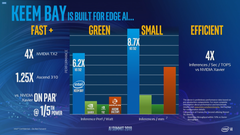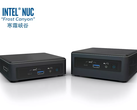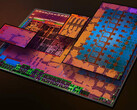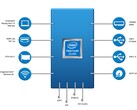Intel offered details on its new vision processing unit (VPU) yesterday morning. Code-named Keem Bay, the new unit is set to offer major performance and efficiency improvements over rival VPUs.
The chip is designed for on-device AI processing (known colloquially as “edge AI”). Keem Bay is a 72-millimeter chip with on-die memory with a 64-bit bandwidth. Intel claims Keem Bay offers 10 times the performance of their previous VPU. But Intel isn’t just focused on improving its own products.
The company claims Keem Bay is four times faster than Nvidia’s TX2 and 1.25 times faster than the Huawei HiSilicon Ascend 310. All of this comes with improved power efficiency, as well; Intel says Keem Bay only draws 20-33% of the power used by Nvidia’s and Huawei’s options.
Jonathan Ballon, Intel’s Vice President of IoT, said of Keem Bay:
It’ll deliver better-than-GPU performance at a fraction of the power, a fraction of the size, and a fraction of the cost of comparable products.
Keem Bay is set to launch in H1 2020.





















